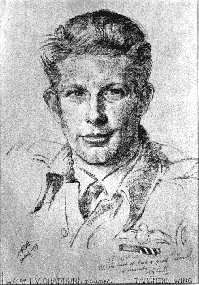Lloyd Chadburn
Born in Montreal, Quebec on August 21st., 1919, Lloyd Chadburn moved with his parents to Oshawa, Ontario as an infant and grew up there, and in Aurora. He worked as a bank clerk at the Bank of Toronto, and as a salesman for the Red Rose Tea Company. Chad, as he became known to his friends, applied to the Royal Canadian Air Force twice in 1939, but was turned down both times. The small pre-war force was not yet ready for an increased enlistment. Shortly after the outbreak of the war, Chadburn was accepted by the Royal Canadian Air Force as an Air Gunner, but re-mustered as a Pilot. He graduated from Number 2 Flight Training School in Ottawa on October 9th, 1940 as a Pilot Officer.
Chad was originally posted to Number 2 RCAF Squadron in England flying the Hawker Hurricane. He made his first operational flight in March of 1941. The Squadron was soon renumbered to 402. He also served a brief period with 412 Squadron (RCAF) and 19 Squadron (RAF).
In February 1942, Chadburn was posted to Number 416 (RCAF) Squadron in Peterhead, Scotland as a Flight Lieutenant. Only days later, he took over command of the Squadron from a British officer, becoming the first graduate of the British Commonwealth Air Training Plan to lead a Fighter Command Squadron. He was also the youngest Squadron Leader in the Air Force at age 21.
Squadron Leader Chadburn and 416 Squadron flew cover missions over Dieppe on August 19th, 1942, saving many Canadian and allied lives. His skill and leadership of the Squadron earned him the Distinguished Flying Cross. His leadership and intense training made the pilots of 416 Squadron the most successful RCAF fighter squadron of the day. After a thirty-day leave in Canada, Chad was posted to 402 Squadron and then 403 Squadron prior to his promotion to Wing Commander in June 1943. He commanded both 402 and 416 Squadrons (RCAF) as well as 118 Squadron (RAF) flying escort for American bomber crews. They called him “The Angel” for his escort would assure them a safe voyage to and from the target. By the time Chadburn left the Digby Wing in December, he had received the Distinguished Service Order twice. He was the first RCAF officer to be so decorated and was one of only four who were.
In early 1944, Wing Commander Chadburn was appointed as Wing Commander of Fighter Operations at Group HQ of the RCAF Overseas. He was sent back to Canada for a War Bond drive in the spring, and upon his return was made Wing Commander of Number 127 RCAF wing, which included 403, 421 and 416 Squadrons.
D-Day operations found Chadburn patrolling with his wing between the front lines and the sea near Caen, France when tragedy struck on June 13th, 1944.
Wing Commander Chadburn was killed in action over Normandy. He was 24 years of age. Canadian and British fighter pilots, as well as American bomber crews, openly wept at the news of the death of the Angel. Wing Commander Chadburn’s record includes 14 enemy airplanes destroyed (4 shared), 6 aircraft probably destroyed (1 shared),6 aircraft damaged (2 shared), two E-boats destroyed, and another 2 damaged, as well as a destroyer damaged.
He was made a Chevalier (knight) in the French Legion d’Honneur as well as being awarded the Croix De Guerre avec Palme. Only three RCAF officers received the Legion d’Honneur, and Chadburn was the only one to receive the Croix de Guerre avec Palme.
More information on Wing Commander Chadburn, and other members of the RCAF may be found at the Canadian Air Aces and Heroes site.
Additional Resources
View: Wing Commander Chadburn’s Aircraft
Read: Personal Memories of Lloyd Vernon Chadburn
View: Chadburn’s Final Resting Place
The Book:“Gone is the Angel”
Video: Watch a short Video of Lloyd Chadburn’s squadron in WW2. (He is the Blonde haired Pilot towards the end of the video.)


